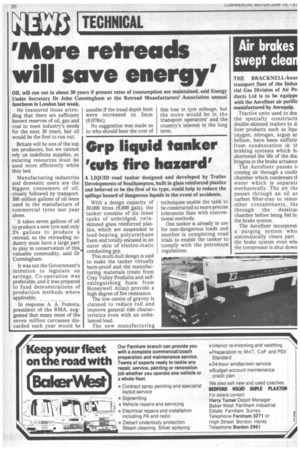'More retreads will save energy'
Page 22

If you've noticed an error in this article please click here to report it so we can fix it.
OIL will run out in about 30 years if present rates of consumption are maintained, said Energy Under Secretary Dr John Cunningham at the Retread Mnaufacturers' Association annual luncheon in London last week.
He reassured those attending that there are sufficient known reserves of oil, gas and coal to meet industry's needs for the next 30 years, but oil would be the first to run out.
Britain will be one of the top ten producers, but we cannot rely on indefinite supplies, so existing resources must be used more efficiently while they last.
Manufacturing industries and domestic users are the biggest consumers of oil, • closely followed by transport. 300 million gallons of oil were used in the manufacture of commercial tyres last year alone.
It takes seven gallons of oil to produce a new tyre and only 21/2 gallons to produce a retread, so the retreading industry must have a large part to play in conservation of this,_ valuable commodity, said Dr Cunningham.
It was not the Government's intention to legislate on savings. Co-operation was preferable, and it was prepared to fund demonstrations of production methods where applicable.
In response A. A. Podesta, president of the RMA, suggested that many more of the seven million carcasses discarded each year would be useable if the tread depth limit were increased to 2mm (0.079in).
No suggestion was made as to who should bear the cost of this loss in tyre mileage, but the move would be in the transport operators' and the country's interest in the long term.
















































































































